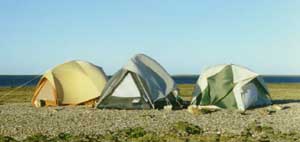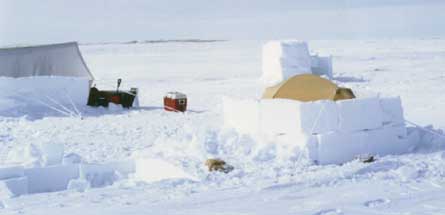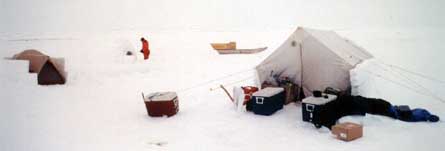
Camping in Tents
Camping in the Arctic differs significantly from camping in the forests or meadows of southern Canada. Numerous factors have to be taken into consideration when chosing a tent:
There are two major categories that tents fall under (no pun intended): free-standing tents and supported tents.
Supported tents require exterior guide ropes that give external strength and support. Without the guide ropes these types of tents would collapse under their own weight, but with these external ropes, walls are pulled taut and with little framing are quite durable. The most common supported tents used in the Arctic are often referred to as Labrador tents, consisting of only a few pieces of wood framing, a canvas shell and of course, the ropes.
Free-standing tents have a more complex frame construction and almost always an internal cocoon and an external fly, or cover. Free-standing means that when the tent is constructed it can literally be picked up and moved intact. But given the nature of Arctic weather, it is advisable to secure the tent extremely well.
Present-day Inuit tend to use the Labrador tent when camping out on the land (away from settlements). These can easily be transported by snowmobile, boat, ATV or even plane, and are suitable for long-term camping and sheltering numerous people, such as extended families. Because they do not have floors, sleeping areas often are lined with foam mattresses, or sometimes animal hides. Cooking can also be done inside these tents as they are quite spacious and as a result, the heat from the stoves is welcomed. It was quite a surprise to enter one of these tents first thing in the morning and see father, sons, uncle and cousins all in a row in their sleeping bags with the Coleman stove brewing the first day's pot of coffee.
Meanwhile, the white guys slept in their individual tent capsules of different designs, quality and sizes of free-standing tents. Free-standing tents can range in size to accommodate one to six people. A tent that is said to accommodate two people usually implies that two sleeping bags faced in opposite directions, and their tooth brushes, could fit in such a tent. In reality, a two person tent fits one person plus hiking gear. Free-standing tents are generally light and therefore easily transportable even when backpacking.
The trick to chosing a tent for Arctic camping is to know how long one will stay in one place, means of transportation, number of individuals, and climate. If the weather is to be extremely cold, chose a tent that accommodates cooking inside or in a vestibule. This requires a larger tent and when the stove is not running the temperature will quickly drop unless there are several individuals to create body heat.
NB: If you are camping in bear country, do not cook in the same tent you sleep in. Likewise, don't eat or store food in your sleeping tent!
If you are camping in fairly clement weather, chose a tent that is sufficient in size for the number of occupants and their gear. Inclement weather means you may be stuck inside your tent for several days, so don't have a tent so small that all you can do inside is lie there inhaling the ceiling. Accordingly, don't take a tent so spacious that your body heat cannot maintain a comfortable temperature inside.
Depending on the time of year camping in the Arctic, a 3 season, 4 season or convertible tent is more suitable. Lately, a 3 season tent will do during the summer season in the Lower Arctic. Four season tents are recommended for non-summer camping and convertible tents are good for both summer, winter and High Arctic camping.
While camping in more southern latitudes one would simply stake any guy ropes to the ground and the tent is secured. In the Arctic, however, there is no ground (at least not where I go). Stakes are useless. Instead, guy ropes are tied to rocks. Rock outlines (tent rings) where people have pitched their tents are still visible even hundreds and thousands of years later. After selecting a suitable camping spot, the rocks have to be gathered. Rocks are also placed inside the tent, especially if the tent is constructed with a fabric floor. Due to the lack of forest, winds can get extreme and lift the tent off the ground. The internal rocks help prevent this from happening. Find flat rocks for this purpose, as round rocks will roll when strong winds batter the tents.

 TWO VIEWS OF THE SAME CAMP, WITH A FREESTANDING SLEEPING TENT AND A LABRADOR TENT FOR COOKING. SNOWBLOCK WALLS HAVE BEEN CONSTRUCTED FOR PROTECTION FROM WIND. THE RECTANGULAR STRUCTURE IN THE BACK IS A SNOWBLOCK OUTHOUSE. IN THE LOWER VIEW YOU CAN SEE IN THE BACKGROUND A SLEDGE FOR HAULING EQUIPMENT, CALLED A KOMATIK, AND A DEREK SMITH BESIDE A SNOW IGLOO.
 |
Tent construction can be a significant concern. Due to the unpredictable strong winds, it is advisable to have a tent that can withstand the worst possible scenerios. I have witnessed brand new tents splintered or flattened within days of being erected. You do not want to find yourself tentless days away from rescue. As already mentioned, the Arctic winds can be incredible. Therefore, if using a free-standing tent, make sure the frame is quality material and/or design. Do not use a tent of inexpensive aluminium tubing or fiberglass; these will bend or shatter at first gale. Is a couple of hundred dollars more worth your life?
I have seen individuals take a substandard tent to the Arctic because it was given to them free by sponsors. Personally, even offered free tents, I choose to take what is tried and true. The tent is camping's closest link to shelter, home and sustainable life. Not surprisingly, I own four different tents and have owned several others that did not suit my needs. As one retailer said, "Quality doesn't cost…it pays".
When picking a camp spot there are four things to look for:
- access to fresh water,
- a fairly even ground surface,
- a dry surface and
- suitable sized rocks available to secure the tent.
Due to the normally rocky surfaces found in the Arctic, a ground sheet is highly recommended. Regardless of the surface, I prefer to place my ground sheet under the tent, primarily to protect the tent floor from abrasion or punctures. Others place their ground sheets inside the tent to protect their gear from water.
The fly, which covers the outside of the tent, should extend almost to the ground at the sides of the tent, as well as partially covering the entrances. Yes, a tent with more than one entrance is a real bonus. You don't want a fly that will act as a parachute when the winds start to blow. I have often been asked about how silent the Arctic must be. Not with those winds shaking the tent! However, with no wind or only a gentle breeze the primary sound is your feet treading against the ground.
